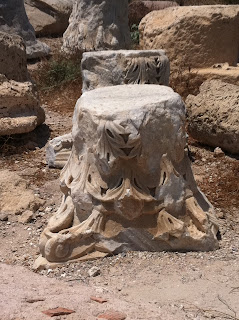Caesarea's antiquities are based around a harbor that was built in Herod the Great's time - and include relics of construction from then and onward, including leftovers from the Romans - a circus for chariot races and an amphitheater that is still in use today. There are remnants of public baths and many different styles of mosaic floor, as well as columns and bits of walls fallen. The harbor itself was the largest artificial harbor of its time, and helped make the city a valuable asset.
 |
| bits of columns |
 |
| the chariot run in the Roman circus |
 |
| amphitheater |
 |
| the Cardo |
 |
| Madaba Map |
 |
| one of the glass-covered pits |
 |
| The Temple Mount and Western Wall |
What I'm getting at, or rather getting to - the history in Israel is really old; they have structures on display (and sometimes on display to such an extent that you can go strolling through and on these ancient pieces, which is just badass) from events recorded in the OLD TESTAMENT. Thousands and thousands of years of history, architecture, and epic reigns are contained in this tiny tiny country. I walked around Jerusalem and Ceasarea and thought "Herod - Herod, that dude who expanded the Second Temple, and father of the Herod who really didn't like Jesus all that much - walked here."
I mean ... damn.
As mentioned in my previous post, that was one of the truly special things about being taken around Israel by my relatives - they told so many stories of Israel's history, both ancient and more recent (since its inception as an independent state in 1948). And we only got a fraction of it this trip, though I remember other stories from past visits, like the siege and mass suicide on Masada, or the Holocaust Museum, or Yad Mordechai, a memorial dedicated to a young leader in the Warsaw Ghetto Uprising in 1943.
And then of course there were the photo albums. My grandparents have photo albums dating back to their respective childhoods, chronically through their youth and married life together, as well as pictures of all the relatives as time goes on. I saw my mother's baby pictures and her teen years, as well as cousinTerra's mother's youth. We found pictures of my aunt Wendy's parents, and even one of a teenage Wendy, as she and my uncle were childhood friends long before they were married.
It was truly a treat for me to get a taste of all this, all the different kinds of history I encountered. But one thought that occurred to me as we drove from Ceasarea to Karmiel to see a folk dancing festival was that ... well that dude-who-is-much-smarter-than-me-and-whom-I-can't-seem-to-track-down-at-the-moment-but-I-know-he-said-it was right: New York has no memory. Or at least not in the same way.
New York has a lot of history to it, too. Battles were fought here. Old structures and notable landmarks are there, hidden in and among all the newer stuff. If you walk below Astor Place along Lafayette you can see those old white columns that are the remnants of what the entire neighborhood used to look like. Streets in the hilly Washington Heights, like Fort George or Fort Washington, are named for the old forts that used to be there long ago. But New York is also very very crowded, so it's all sort of sandwiched in together. So across from those white columns on Lafayette is the Public Theater, which used to be The Astory Library, a branch of the New York Public Library, and which also used to be HIAS, a place of refuge for displaced Jews. But also across from those white columns is a very tall, very shiny, very new bank building.
New York has its history. But a lot of us just don't notice. Part of that is the large proportion of people in New York who are not genuine natives - they (or rather we) came to New York for what it has to offer now - for its present and its future - so many of us have never bothered to learn about its past. Which is fine; we don't necessarily have to. But the past is such an integral part of many Israelis, both natives and immigrants, that the contrast is very strong.
When we walked along Jerusalem streets or the West Bank, Bella told us of its ancient past and meaning; when I walk along Astor Place with guests, I am more likely to tell an amusing anecdote about the plentiful amount of Starbucks than to tell the story of the Astor Place Riots, which began where one of those Starbucks now operates.
New York's history for its citizens, perhaps, is more about the stories we create ourselves. Israel's history, while that too, is also about the stories we've been creating - and surviving - for centuries.
No comments:
Post a Comment